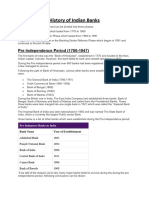Small Finance Bank and Financial Inclusion - A Case Study of Ujjivan Small Finance Bank
Small Finance Bank and Financial Inclusion - A Case Study of Ujjivan Small Finance Bank
Uploaded by
Navneet LohchabCopyright:
Available Formats
Small Finance Bank and Financial Inclusion - A Case Study of Ujjivan Small Finance Bank
Small Finance Bank and Financial Inclusion - A Case Study of Ujjivan Small Finance Bank
Uploaded by
Navneet LohchabOriginal Title
Copyright
Available Formats
Share this document
Did you find this document useful?
Is this content inappropriate?
Copyright:
Available Formats
Small Finance Bank and Financial Inclusion - A Case Study of Ujjivan Small Finance Bank
Small Finance Bank and Financial Inclusion - A Case Study of Ujjivan Small Finance Bank
Uploaded by
Navneet LohchabCopyright:
Available Formats
See discussions, stats, and author profiles for this publication at: https://www.researchgate.
net/publication/339849971
SMALL FINANCE BANK AND FINANCIAL INCLUSION -A CASE STUDY OF
UJJIVAN SMALL FINANCE BANK
Article · February 2020
CITATIONS READS
0 404
2 authors, including:
Kittu R S
Bangalore University
3 PUBLICATIONS 0 CITATIONS
SEE PROFILE
Some of the authors of this publication are also working on these related projects:
Differentiated Banking License for Financial Inclusion View project
All content following this page was uploaded by Kittu R S on 11 March 2020.
The user has requested enhancement of the downloaded file.
ISSN: 0474-9030
Our Heritage Vol-68-Issue-54-February-2020
(UGC CARE JOURNAL)
SMALL FINANCE BANK AND FINANCIAL
INCLUSION - A CASE STUDY OF UJJIVAN SMALL
FINANCE BANK
R.S.KITTU, Research Scholar,
Department of Commerce,
KLE Society’s S. Nijalingappa College,
Rajajinagar, Bangalore - 560 010, Karnataka
Dr. MAHANANDA B CHITTAWADAGI, Associate Professor,
Department of Commerce,
KLE Society’s S. Nijalingappa College,
Rajajinagar, Bangalore - 560 010, Karnataka
Abstract
The term "financial inclusion" has gained importance since the early
2000s, a result of identifying financial exclusion and it is a direct correlation to
poverty according to the World Bank. Despite the growth which the banking
sector has made especially in the last two decades, there are concerns that banks
have not been able to include vast segments of the population, especially the
disadvantage sections of the society. In the Indian context, the term ‘financial
inclusion’ was used for the first time in April 2005 in the Annual Policy Statement
presented by Y.Venugopal Reddy, the Governor, Reserve Bank of India. Estimate
and surveys of different study reports point out that exclusion levels of people in
India is estimated to be around 40%. Financial access to the lower income strata
of the society at an affordable cost is a requirement for poverty reduction and
social cohesion. It is a key step for progress and growth. Under this the several
initiatives have been taken by the Government of India, Reserve Bank of India
and various other agencies to improve the financial inclusion scenario in the
country. This paper discusses the various aspects of financial inclusion and the
role of SFB in expanding the access to finance agenda of the government.
Key words: Differentiated banking license, financial inclusion, small finance
banks, micro finance, etc.
1. Introduction
Government of India has taken many initiatives. Commercial banks play a
vital role in the economic development of the society by ensuring mobilization of
savings and providing credit to various poverty eradication programmes.
Likewise, different institutions such as Industrial Development Bank of India,
Industrial Finance Corporation of India, and Small Industrial Development Bank
of India are functioning to fulfill various financial requirements of different
P a g e | 267 Copyright ⓒ 2020 Authors
ISSN: 0474-9030
Our Heritage Vol-68-Issue-54-February-2020
(UGC CARE JOURNAL)
segments of the country. Also Co-operative Banks, Regional Rural Banks and
Local Area Banks are institutionalized by Reserve Bank of India to focus on
financial inclusion programmes and satisfy the financial needs of small customers
in rural and semi-urban areas. All these financial institutions have not fully
succeeded to cater to the entire society, mainly rural and semi-urban small
customers because of organizational limitations and financial illiteracy. The
concept of Small finance Bank is the new step taken by RBI to bring unbanked
and under-banked community under the territory of banking sector. Hence, RBI
issued license to ten institutions to start SFB in the nation. As Micro Finance
Institutions have been practicing among rural people for long time, they are in a
position to understand the credit needs of rural area and semi-urban under-served
population. These small finance banks are new and innovative in the formal
banking sector. In case of small banks, deposits and loans are provided by small
banks for small areas. Farmers, small and medium entrepreneurs and other
unorganized sector people are getting assistance from small finance banks.
Chances are rendered for micro finance institutions and no- banking financial
companies to set up small finance banks. License should be granted for such
micro finance institutions and non banking financial companies to start small
finance banks which will serve for a quarter of rural branching and a half of loan
facilities to farmers, micro, small and medium entrepreneurs. License for small
finance banks cannot be applicable to co-operative banks. From the point of view
subsidiaries, small finance banks cannot have their subsidiaries. Investment in
government securities is permitted but fixed deposits or loans are not admitted.
Concern of payment bank focuses on the poor people, migrants, and the
unorganized. Payments and remittance to the poor, migrant and the unorganized
can also be possible via post.
2. Small finance bank
Small Finance Bank is a type of bank in India which is globally known as
‘Niche Banks’. The SFBs are registered as a public limited company under the
Companies Act, 2013. They are licensed under Section 22 of the Banking
P a g e | 268 Copyright ⓒ 2020 Authors
ISSN: 0474-9030
Our Heritage Vol-68-Issue-54-February-2020
(UGC CARE JOURNAL)
Regulation Act, 1949. Also, SFBs can be given scheduled bank status once they
commence their operations, and qualify the requirements as per Section 42(6) (a)
of the Reserve Bank of India Act, 1934. The SFBs are scaled down versions of
scheduled commercial banks, with both deposit-taking and loan making functions.
Small banks can play vital role in lending loans in small scale. Reserve Bank of
India prefers to have small banks that can serve for poor people. Small banks can
extend their banking activities to the rural masses. Reserve Bank of India also
gives preference to take banking to the rural poor people. By having small banks,
India wishes to develop a network of small and focused lenders. These small
banks specifically target the low-income segment in the country. These types of
small banks are similar to US community banks. These small banks undertake
their banking operation as commercial banks but in a limited scale. These small
banks are an opportunity for low-income segments but not to big borrowers.
Reserve Bank of India announced 8 out of 10 Microfinance Institutions as small
finance banks in-principle. These are Au Financiers (India) Ltd, Capital Local
Area Bank Ltd, Disha Microfin Pvt. Ltd, Equitas Holdings Pvt. Ltd, ESAF
Microfinance and Investments Pvt. Ltd, Janalakshmi Financial Services Pvt. Ltd,
RGVN (North East) Microfinance Ltd, Suryoday Micro Finance Pvt. Ltd, Ujjivan
Financial Services Pvt. Ltd and Utkarsh Micro Finance Pvt. Ltd. Eight out of these
10 entities are micro-finance institutions, one is a local area bank and one is a non-
banking financial company. Ujjivan Small Finance Bank Limited is a subsidiary
of Ujjivan Financial Service Private Limited based in Bangalore and started its
operations in the city in February 2017. Ujjivan Small Finance Bank currently has
branches in 15 states. It offers a variety of financial products and services to poor
people in India who do not have access to formal banking system.
3. Review of literature
Acharya (2017) stated that the Reserve Bank of India is influential in
promoting the idea of small finance banks to make available banking services to
unbanked region. It is necessary as per RBI norms that these banks have to
operate at least 25% of its branches in unbanked areas to give financial assistance
P a g e | 269 Copyright ⓒ 2020 Authors
ISSN: 0474-9030
Our Heritage Vol-68-Issue-54-February-2020
(UGC CARE JOURNAL)
to rural poor. Banks can expand their banking outlets and build sure the services
to poor community in unbanked areas.
Bandyopadhyay (2017) stated that 75% of small finance bank loans have
to be disbursed to priority sectors. Demonetization progress affected MFI-turned-
small finance banks as it increased the amount of non-performing assets. Cash is
the base for their business form and small customers from informal sectors cannot
easily acknowledge cash-less business model. By adopting enhanced technology
system and practiced employees, SFBs can achieve the RBI’s goal to provide
financial assistance to unbanked population.
Ninan (2017) stated that out of 10 SFBs, 8 are from microfinance
institutions and this is a clear indication of the contributions of MFIs to financial
inclusion procedure. SFBs can serve healthier the un-served rural population by
issuing small amount of credits to meet their variety of life cycle necessities.
Ray (2017) stated that small finance bank is a modern progress in the
Indian banking industry to expand financial aids among rural and semi-urban
poor. They adopt differential form of delivery apart as of scheduled commercial
banks to achieve out to the needy. Small finance banks have to extend sufficient
infrastructures and skilled manpower in order to accomplish their assigned
errands.
Ravi Singh (2016) stated that the financial inclusion is the key purpose of
yielding license to set up small finance banks to offered non-banking finance
companies and local area bank. These banks comprise to hub on lending low-
value customers at the base level of the society.
Morbia (2016) express that the small finance banks are permitted to carry
out the essential banking services such as accepting deposits and lend money,
essentially to low-income groups. Since functioning as banks, the interest charges
can be bargain, so the low-value customers, small and medium enterprises can
have the benefit of low cost credits. Institutions, transform into small finance
P a g e | 270 Copyright ⓒ 2020 Authors
ISSN: 0474-9030
Our Heritage Vol-68-Issue-54-February-2020
(UGC CARE JOURNAL)
banks are in a situation to comprehend the financial essentials of rural poor. By
given that bank loans, these banks assist rural population to reduce the poverty.
4. Statement of the problem
Commercial banks and other financial entities are not efficiently serving
the rural population, because of lack of perceptive the credit requirements. They
are for the most part interested in providing finance to huge and medium scale
corporates and urban customers. In our nation, greater part of the people belongs
to low and middle income group in rural India, formal banking amenities are still
a scant product. Micro and small enterprises and customers particularly from rural
and semi urban areas are to a certain extent served by private financial institutions
and local money lenders. The concept of small finance bank is an inventive step
taken by policy makers to serve the un-served and under-served rural population.
Small finance banks have healthier knowledge of the financial requirements of
rural community because, the majority of these banks were functioning as MFIs
and their employees have superior knowledge about the credit needs of rural
customers. In this context, the present study tries to analyze the role of small
finance banks in promoting financial inclusion.
5. Objectives of the study
1. To understand the concept of small finance banks and financial inclusion.
2. To know the role of small finance banks in financial inclusion.
3. To examine the effect of small finance banks on financial inclusion.
6. Research methodology
The study is based on secondary data. To study the role of small finance
banks in promoting financial inclusion and rural population, the secondary data
are collected from various journals, publications and websites.
P a g e | 271 Copyright ⓒ 2020 Authors
ISSN: 0474-9030
Our Heritage Vol-68-Issue-54-February-2020
(UGC CARE JOURNAL)
7. Findings
1. Ujjivan Small Finance Bank undertakes meticulous appraisal of its clients
before giving them loans. This includes examining the household income,
expenses as well as indebtedness.
2. In the majority of large branches, Ujjivan Small Finance Bank has appointed
dedicated customer care representatives. The customer care representatives
have the responsibility to collect customer feedback and respond to their
queries and complaints.
3. The organization has drafted a code of conduct for its staff members. This
code emphasizes on transparent behaviour and professional conduct of staff
members towards clients.
8. Suggestions
1. Government of India and RBI decided to start small finance banks as the part
of financial inclusion to ensure better banking services to every section of the
society. To achieve this objective, SFBs have to follow low-cost operations
system based on the latest technological tools.
2. Two main challenges of SFBs are talented work force and advanced
technology. The existing staff needs to be properly trained to sell new
products of SFBs and take deposits. In order to reach un-served and under-
served rural areas, SFBs can adopt low-cost, mobile based technologies.
3. Ujjivan Small Finance Bank can offer financial support to small business units
and micro and small industries. In the mean time, adequate training can
provide to these units as well as the interested rural people to develop
entrepreneurship skills so that they can manage their business more effectively
and efficiently.
4. Majority of customers are from the rural areas. Hence, financial literacy is
another concern faced by t Ujjivan Small Finance Bank. Financial education
P a g e | 272 Copyright ⓒ 2020 Authors
ISSN: 0474-9030
Our Heritage Vol-68-Issue-54-February-2020
(UGC CARE JOURNAL)
and counseling help the rural people to invest money productively in their
ventures.
5. They will become aware of the benefits of good credit records and timely
settlement of credit. These small-valued population need to be educated about
e-money and cashless business model to reduce the use of cash as India is
moving towards digital economy.
6. Many clients and some staff members were found not to be aware of declining
balance interest rate charged by Ujjivan Small Finance Bank. The organization
should try to improve this awareness.
7. System of dissemination of grievance redressal mechanism requires
improvement to ensure that all clients are aware of it and there is a mechanism
to cross-check if there is satisfactory and timely redressal of all complaints.
9. Conclusion
Small finance bank is the appropriate step taken by the Government of
India and RBI to bring the isolated un-banked and the under-banked community
under the domain of formal banking system. Most of these entities were working
as MFIs for a long period of time; they are in a better position to understand the
credit needs of rural poor. Therefore, authorities can efficiently execute micro,
small and medium level of credit programmes through small finance banks. In our
country, more than half of the population belongs to low-to-middle income group
and are residents in rural area. Financial Inclusion is the major tool to assist the
un-served and underserved community for enhancing their economic and social
life. So it can be restated that, small finance banks have important role to improve
the economic as well as social status of rural area beneficiaries through financial
inclusion.
10. Reference
Gandhi, M M. (2013). Role of banks in financial inclusion in India: Issues,
challenges and strategies, JABERM, II, 168-169.
P a g e | 273 Copyright ⓒ 2020 Authors
ISSN: 0474-9030
Our Heritage Vol-68-Issue-54-February-2020
(UGC CARE JOURNAL)
Jeeban Jyoti Mohanty (2018). Leveraging small financial banks in achieving
financial inclusion in India. International Journal of Business and
Management Invention. 7 (2), 8-18.
Gupte, R., Venkataramani, B., & Gupta, D. (2012). Computation of financial
inclusion index for India. Procedia-Social and Behavioral Sciences, 37,
133-149.
Dangi, N., & Kumar, P. (2013). Current situation of financial inclusion in India
and its future visions. International Journal of Management and Social
Sciences Research, 2 (8) 155-166.
P a g e | 274 Copyright ⓒ 2020 Authors
ISSN: 0474-9030
Our Heritage Vol-68-Issue-54-February-2020
(UGC CARE JOURNAL)
Soumya N, Sustainable E-Banking challenges in selected Manufacturing industries in
Mysuru city, International journal of Mechanical Engineering and Technology
9(1), 2018, pp. 229- 239
P a g e | 275 Copyright ⓒ 2020 Authors
View publication stats
You might also like
- Regional Rural Banks of India: Evolution, Performance and ManagementFrom EverandRegional Rural Banks of India: Evolution, Performance and ManagementNo ratings yet
- Yes Bank Mainstreaming Development Into Indian BankingDocument20 pagesYes Bank Mainstreaming Development Into Indian Bankinggauarv_singh13No ratings yet
- A Study On Credit Appraisal Process On Lotak Mahindra Bank (Draft)Document54 pagesA Study On Credit Appraisal Process On Lotak Mahindra Bank (Draft)Rhea SrivastavaNo ratings yet
- JETIR1806472Document9 pagesJETIR1806472Nirvana CélesteNo ratings yet
- TASK - 13 Qualitative AnalysisDocument4 pagesTASK - 13 Qualitative AnalysisBijosh ThomasNo ratings yet
- Topic: Role of Commercial Banks in India: Name: Megha Singh Class: FYBSC Roll - No: 26 Semester - 1Document16 pagesTopic: Role of Commercial Banks in India: Name: Megha Singh Class: FYBSC Roll - No: 26 Semester - 1026 Megha SinghNo ratings yet
- A Study On Credit Risk ManagementDocument44 pagesA Study On Credit Risk ManagementShabreen Sultana100% (1)
- Micro Finance - Keys & Challenges:-A Review Mohit RewariDocument13 pagesMicro Finance - Keys & Challenges:-A Review Mohit Rewarisonia khuranaNo ratings yet
- Winter Project On Banking: Idbi BankDocument18 pagesWinter Project On Banking: Idbi BankMudit JiNo ratings yet
- 0 - A Study On Competency Mapping in Ujjivan Small Finance BankDocument8 pages0 - A Study On Competency Mapping in Ujjivan Small Finance BankPRANUNo ratings yet
- Project Report On Indian Banking SectorDocument15 pagesProject Report On Indian Banking SectorAbhishek MohantyNo ratings yet
- SemIX. Banking Law - Abhijeet Mishra - Project.03Document22 pagesSemIX. Banking Law - Abhijeet Mishra - Project.03AbhijeetMishraNo ratings yet
- Priyanka+Agarwal+20 25Document6 pagesPriyanka+Agarwal+20 25elunshsharmaNo ratings yet
- A Study of Non-Performing Assets of Microfinance InstitutionsDocument11 pagesA Study of Non-Performing Assets of Microfinance InstitutionsPalak ParakhNo ratings yet
- Comparative Study On Seavices of Public Sector and Private Sector Banks OptDocument49 pagesComparative Study On Seavices of Public Sector and Private Sector Banks OptWashik Malik100% (1)
- Damodaram Sanjivayya National Law University Visakhapatnam, A.P., IndiaDocument19 pagesDamodaram Sanjivayya National Law University Visakhapatnam, A.P., IndiaAbhijit Singh ChaturvediNo ratings yet
- Project Vijaya Bank FinalDocument62 pagesProject Vijaya Bank FinalNalina Gs G100% (1)
- A Study On Financial Inclusion Initiation by State Bank of IndiaDocument5 pagesA Study On Financial Inclusion Initiation by State Bank of IndiavmktptNo ratings yet
- Banking StructureDocument3 pagesBanking StructureMayank AhujaNo ratings yet
- PROJECT Regarding Consumer AwarenessDocument34 pagesPROJECT Regarding Consumer AwarenessNavjot Mangat44% (9)
- Money and BankingDocument22 pagesMoney and Bankingguptashivangi944No ratings yet
- Small Finance Indian Book PDFDocument84 pagesSmall Finance Indian Book PDFrajeshraj0112No ratings yet
- Summer ProjectDocument68 pagesSummer Projectgauravgupta18290No ratings yet
- Issues and Challenges in Indian Banking SectorDocument7 pagesIssues and Challenges in Indian Banking Sectorbhattcomputer3015No ratings yet
- Role of Banks in The Development of Indian Economy: Prof. Jagdeep KumariDocument4 pagesRole of Banks in The Development of Indian Economy: Prof. Jagdeep KumariJOEL JOHNNo ratings yet
- The Microfinance Industry in IndiaDocument3 pagesThe Microfinance Industry in IndiaPrashant Upashi SonuNo ratings yet
- Recent Trends in BankingDocument16 pagesRecent Trends in BankingManisha S. BhattNo ratings yet
- A Comparative Study On Public & Private Sector Banks: A Special Reference To Financial Performance, Non-Performing Assets and Employee MoraleDocument11 pagesA Comparative Study On Public & Private Sector Banks: A Special Reference To Financial Performance, Non-Performing Assets and Employee Moralevansham malikNo ratings yet
- Preface: of Public Sector and Private Sector Banks"Document47 pagesPreface: of Public Sector and Private Sector Banks"madhuri100% (1)
- Structure of The Indian Banking Industry: Commercial BanksDocument2 pagesStructure of The Indian Banking Industry: Commercial BanksMayank AhujaNo ratings yet
- ICICI Go Global Case PDFDocument15 pagesICICI Go Global Case PDFSAGAR BALAGARNo ratings yet
- Corporation Bank Report FinalDocument61 pagesCorporation Bank Report FinalJasmandeep brarNo ratings yet
- Credit Risk Project PDFDocument104 pagesCredit Risk Project PDFDenish PatelNo ratings yet
- Dena BNK Project FinalDocument82 pagesDena BNK Project FinalNirmal MudaliyarNo ratings yet
- Challenges and Opportunities Indian BanksDocument4 pagesChallenges and Opportunities Indian BanksNitin NagpureNo ratings yet
- A Report OnDocument26 pagesA Report OnNihar HindochaNo ratings yet
- Executive Summery SONALI 11111111Document68 pagesExecutive Summery SONALI 11111111idealNo ratings yet
- v9n2 Paper2Document11 pagesv9n2 Paper2amitmali.armNo ratings yet
- A Study On Recent Trends of Banking Sector in India: M.Sujatha, N.V Haritha, P. Sai SreejaDocument8 pagesA Study On Recent Trends of Banking Sector in India: M.Sujatha, N.V Haritha, P. Sai Sreejasomprakash giriNo ratings yet
- Main DataDocument59 pagesMain Datachinmay parsekarNo ratings yet
- (2013 - IJMSSR) Dangi&Kumar - Current Situation of Financial Incl. in India PDFDocument12 pages(2013 - IJMSSR) Dangi&Kumar - Current Situation of Financial Incl. in India PDFMarkus WidodoNo ratings yet
- Project of SyndicaticDocument42 pagesProject of SyndicaticSaad KalaveNo ratings yet
- Digital MarketingDocument7 pagesDigital Marketingviratviral48No ratings yet
- Comparative Study On Services of Public Sector and Private Sector BanksDocument49 pagesComparative Study On Services of Public Sector and Private Sector BanksvimalaNo ratings yet
- Radhika Project ReportDocument114 pagesRadhika Project ReportrajapatnaNo ratings yet
- Comparative Study of Top 5 Banks in IndiaDocument11 pagesComparative Study of Top 5 Banks in Indiajakharpardeepjakhar_No ratings yet
- CITIBANKDocument28 pagesCITIBANKAnirudh SinghNo ratings yet
- AuthorizationDocument12 pagesAuthorizationShinam AlimNo ratings yet
- Lovely Professional University Department of ManagementDocument23 pagesLovely Professional University Department of ManagementNishant SharmaNo ratings yet
- Summer Internship Program: Leveraging Digital Channels For EnhancingDocument52 pagesSummer Internship Program: Leveraging Digital Channels For Enhancingtom pierceNo ratings yet
- Economics ProjectDocument16 pagesEconomics ProjectYashvardhanNo ratings yet
- Project Proposal SBI MicrofinanceDocument7 pagesProject Proposal SBI MicrofinanceKiran Chopra100% (1)
- Nonfund Banking BusinessDocument95 pagesNonfund Banking BusinessAnkita GargNo ratings yet
- Comparative Study On Services of Public Sector and Private Sector BanksDocument48 pagesComparative Study On Services of Public Sector and Private Sector BanksRanjan Kishor92% (13)
- Msme FinanceDocument65 pagesMsme FinanceGauri MittalNo ratings yet
- Ing Vysya Bank Project NewDocument15 pagesIng Vysya Bank Project NewPrathyusha KoguruNo ratings yet
- Bank of IndiaDocument22 pagesBank of IndiaLeeladhar Nagar100% (1)
- Credit Risk at Sbi Project Report Mba FinanceDocument103 pagesCredit Risk at Sbi Project Report Mba FinanceBabasab Patil (Karrisatte)100% (3)
- Banking India: Accepting Deposits for the Purpose of LendingFrom EverandBanking India: Accepting Deposits for the Purpose of LendingNo ratings yet
- T R A N S F O R M A T I O N: THREE DECADES OF INDIA’S FINANCIAL AND BANKING SECTOR REFORMS (1991–2021)From EverandT R A N S F O R M A T I O N: THREE DECADES OF INDIA’S FINANCIAL AND BANKING SECTOR REFORMS (1991–2021)No ratings yet
- TCH302-Topic 3&4-Time Value of Money & Applications PDFDocument38 pagesTCH302-Topic 3&4-Time Value of Money & Applications PDFHà ThưNo ratings yet
- Partnership 5Document7 pagesPartnership 5Daniel Klint Richter CareNo ratings yet
- Risk Management and InsuranceDocument20 pagesRisk Management and Insuranceወሬ ነጋሪ- oduu himaaNo ratings yet
- Africa Trade and Covid 19: The Supply Chain DimensionDocument53 pagesAfrica Trade and Covid 19: The Supply Chain Dimensionrajasekar venkatesanNo ratings yet
- History of Indian BanksDocument4 pagesHistory of Indian BanksVignesh IyerNo ratings yet
- OB Mini ProjectDocument34 pagesOB Mini ProjectDiksha KumariNo ratings yet
- Creative Chocolate in Nigera To Test Market or NotDocument4 pagesCreative Chocolate in Nigera To Test Market or Notmatthew amadeusNo ratings yet
- D VPFWRNL HH77 H IQqDocument13 pagesD VPFWRNL HH77 H IQqManoj Kumar SinghNo ratings yet
- Accounting Nov 2015 Memo EngDocument15 pagesAccounting Nov 2015 Memo EngAbubakr IsmailNo ratings yet
- Activity 1 Entrepreneurial MindDocument2 pagesActivity 1 Entrepreneurial MindRegina PayumoNo ratings yet
- A Primer On The Taguchi Method - 1Document259 pagesA Primer On The Taguchi Method - 1belaywondwosen72100% (1)
- A Comparative Study On Cash Flow Statements of HDFC Bank and Icici BankDocument59 pagesA Comparative Study On Cash Flow Statements of HDFC Bank and Icici BankPrasanna BelligattiNo ratings yet
- Ceo Exec BriefDocument22 pagesCeo Exec BriefJulia El SamraNo ratings yet
- CIPS L5M4 Advanced Contract & Financial Management - LO1 1.1Document4 pagesCIPS L5M4 Advanced Contract & Financial Management - LO1 1.1Tlotlo RamotlhabiNo ratings yet
- CPS001 PDFDocument1 pageCPS001 PDFmino pharmNo ratings yet
- CV Cristian Rotaru - English RevDocument5 pagesCV Cristian Rotaru - English RevRotaru CristianNo ratings yet
- MNPDocument22 pagesMNPdilipdoneNo ratings yet
- LMA5042Document2 pagesLMA5042gpurkissNo ratings yet
- Unit 3 Growth and Structural Change: 3.0 ObjectivesDocument17 pagesUnit 3 Growth and Structural Change: 3.0 ObjectivesDurgesh JhariyaNo ratings yet
- 09000000000015119142Document1 page09000000000015119142celle0625No ratings yet
- International Business and Trade Jonnard ClaudeDocument312 pagesInternational Business and Trade Jonnard ClaudeCamille LibradillaNo ratings yet
- Icici Bank Sapphiro Credit Card Membership KitDocument16 pagesIcici Bank Sapphiro Credit Card Membership KitVenuNo ratings yet
- Lalaine Espina - Business Finance-Interest RateDocument2 pagesLalaine Espina - Business Finance-Interest RateLalaine EspinaNo ratings yet
- Economics Answering Tips by Chebet Eli PDFDocument16 pagesEconomics Answering Tips by Chebet Eli PDFchebeteli4No ratings yet
- Super CleanDocument12 pagesSuper CleanIbrahim AbdullahiNo ratings yet
- Ipu Indian Economic DevelopmentDocument48 pagesIpu Indian Economic DevelopmentAsfiyaNo ratings yet
- Classification of ContractsDocument15 pagesClassification of ContractsCarloNo ratings yet
- OS 100 ListDocument16 pagesOS 100 ListKUMARPRAVEEN9211No ratings yet
- Long Quiz in Tax 321 FinalDocument2 pagesLong Quiz in Tax 321 Finallanz oronceNo ratings yet
- PBD Module 1 NotesDocument13 pagesPBD Module 1 Notesafshots422No ratings yet

























































































